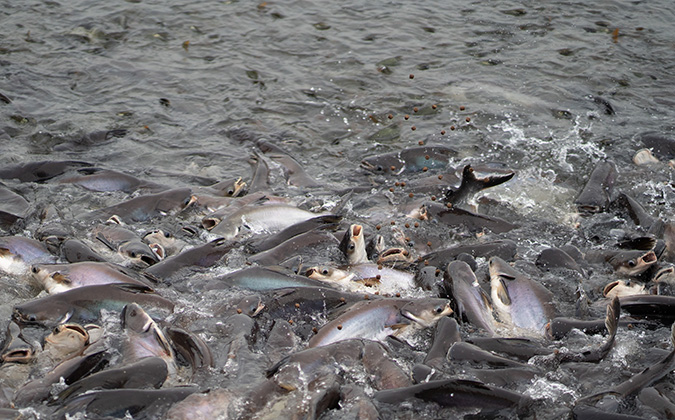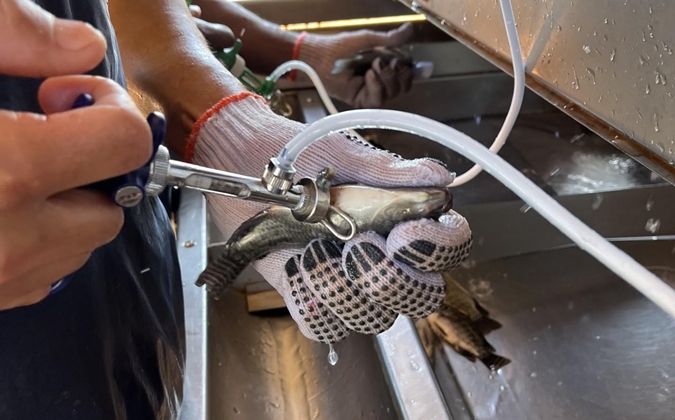
Stomach-resistant oral vaccines could offer fish farmers easier vaccine administration
Oral vaccines hold a great deal of promise for fish farmers. Easier and quicker to administer than injected vaccines, they are also potentially suitable for fish that are too small for injection vaccination, including larval stages.
At present, however, they are much less effective than injected vaccines or those administered through immersion (dip or bath). Very few are licensed. One of the main challenges to overcome with oral vaccines is the effect that gastric acids and digestive enzymes in fish stomachs can have on antigens — the active component of a vaccine — before they take effect.
A new analysis of oral vaccines by scientists in India suggests that newer stomach-resistant designs of the drugs could overcome this problem.
Encapsulating oral vaccines
Traditionally, oral vaccines are sprayed onto, or mixed into, feed. This formulated feed allows many fish to be vaccinated at the same time, bringing time and labour savings for farmers, the researchers wrote in Aquaculture International. They are cheaper than immersion techniques and offer inoculation without the intensive handling associated with injections, meaning the process is stress-free for fish.
But the destructive action of fish stomachs prevent the vaccines from reaching the hindgut — the colon and rectum — where immune cells take up the antigens to produce a response against the target pathogens.
The proposed solution lies in giving oral vaccines a protective layer, the researchers said. Trials of encapsulated oral vaccines for fish have produced mixed results of between 0% and 92% effectiveness, depending on the design, disease and species. But further research and development could help them fulfil their promise of providing a cost-effective and welfare-friendly disease prevention measure.
Nanomaterial-based capsules
Among the encapsulation options offered, those with a nanomaterial-based coating are particularly promising, the researchers said. These include coatings made of chitosan, a biodegradable, biocompatible, and non-toxic polymer made from a natural substance, chitin, found in crustacean and insect shells.
Early studies have delivered interesting results. A carbon chitosan-coated antigen against vibriosis in turbot, for example, was shown to remain stable in stomach acid before its release in the intestine.
Delivering vaccines in live feed
Live feeds that double as vaccine carriers were shown to produce better results than standard formulated feed. Studies have explored giving vaccines to fish in live artemia, daphnia and rotifers.
These “bioencapsulated” vaccines survive the stomach. They also have the advantage of being suitable for fish larvae, which cannot be injected due to their size. Research shows bioencapsulated vaccines can reduce both bacterial infections, such as vibriosis, and viral infections, including oral nervous necrosis virus in orange-spotted grouper larvae.
The future for oral vaccines in aquaculture
Other coating options include algae-based biopolymers and liposomes — lipid-based particles. Researchers are also investigating engineered microorganisms, like yeast, for this purpose.
The scientists predicted that mass vaccination of fish entirely through live feeds may one day come to be widely practiced. It avoids the high costs of producing vaccines for injection and immersion immunization and could offer improved efficacy compared with existing oral formulations.
“Vaccination appears to be the most significant and sustainable solution for controlling and averting disease outbreaks in aquaculture,” they wrote. “In comparison with other vaccination methods, oral vaccination methods impose less stress…along with easier administration.”
To improve oral vaccines’ efficacy, they advised that future research explores dosage, the nature of antigens, formulations, the process of immune reactions and the best age to vaccinate different species.
You can read the full journal article in Aquaculture International.
Posted on: March 27, 2023






